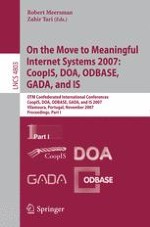2007 | Buch
On the Move to Meaningful Internet Systems 2007: CoopIS, DOA, ODBASE, GADA, and IS
OTM Confederated International Conferences CoopIS, DOA, ODBASE, GADA, and IS 2007, Vilamoura, Portugal, November 25-30, 2007, Proceedings, Part I
herausgegeben von: Robert Meersman, Zahir Tari
Verlag: Springer Berlin Heidelberg
Buchreihe : Lecture Notes in Computer Science
